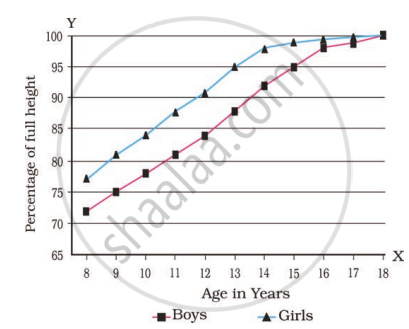Advertisements
Advertisements
Question
Name the kind of diseases/disorders that are likely to occur in humans if
(i) mutation in the gene that codes for an enzyme phenyl alanine hydrolase occurs,
(ii) there is an extra copy of chromosome 21,
(iii) the karyotype is XXY.
Solution
(i) Phenylketonuria is the disorder that occur in humans due to the mutation in the gene (phenylalanine) that codes for an enzyme phenylalanine hydroxylase.
(ii) Down syndrome is the disorder that occur in humans if there is an extra copy of chromosome no. 21.
(iii) Klinefelter's syndrome is the disorder that occur in humans if the karyotype is XXY.
APPEARS IN
RELATED QUESTIONS
What are the measures one has to take to prevent from contracting STDs?
State True/False with explanation.
Creating awareness about sex related aspects is an effective method to improve reproductive health of the people.
What is amniocentesis and why there is a statutory ban on it?
Name the contraceptive device used by the human males which acts as a sheath over the male organ and traps the sperms in it.
Name the contraceptive device used by human females which is put over the cervix.
How does copper-T prevent pregnancy?
People who die from AIDS are not killed by the virus itself. Explain.
Which of the following method of contraception protects a person from acquiring a sexually transmitted disease?
(a) oral pills
(b) condom
(c) copper-T
(d) surgery
In the surgical method of birth control available for males, the structures A in the reproductive system are cut and ligated (tied up) at both ends. This prevents the reproductive cells B from coming out from the organs C where they are made in the male body. Since B cannot come out from the male body, they cannot fuse with cell D in the body of a female and hence pregnancy is prevented.
(a) What are structures A?
(b) What are cells B?
(c) Name the organs C.
(d) What is cell D?
(e) What is the name of this surgical procedure for birth control available to males?
List four ways of preventing pregnancy. State two advantages of using such preventive methods.
What is contraception ? List three reasons for adopting contraceptive methods.
Define the Amniocentesis.
Expand the following abbreviation: IUCD
What is contraception? List four different methods. State four reasons for adopting contraceptive methods.
What can you suggest to your classmates to keep himself/herself clean and healthy?
What is the need for contraception?
What are the strategies to be implemented in India to attain total reproductive health?
The family planning programmes in India were initiated in ______.
RCH stands for ______.
The technique which makes use of amniotic fluid for the detection of prenatal disorder is called as ______.
Which of the following method of contraception protects from acquiring sexually transmitted diseases?
Colonies of yeast fail to multiply in water, but multiply in sugar solution. Give one reason for this.
Would a Planaria cut vertically into two halves regenerate into two individuals? Complete Figure D and E by indicating the regenerated regions.
 |
 |
 |
 |
|
| A | B | C | D | E |
Observe the chart and graph given in figure carefully and answer the following questions.

| Age in Years | % of full height | |
| Boys | Girls | |
| 8 | 72% | 77% |
| 9 | 75% | 81% |
| 10 | 78% | 84% |
| 11 | 81% | 88% |
| 12 | 84% | 91% |
| 13 | 88% | 95% |
| 14 | 92% | 98% |
| 15 | 95% | 99% |
| 16 | 98% | 99.5% |
| 17 | 99% | 100% |
| 18 | 100% | 100% |
- Which of the line represents the height of boys?
- Which line represents the height of girls?
- What is the difference between the pattern of increase in the height of boys and girls?
- Is this pattern true for each individual?
State one drawback of the following:
Oral contraceptive pills
Given below are four aspects of Reproductive Health in Column A and their related information in Column B:
| Column A | Column B | ||
| S. No. | Terms used in Reproductive Health | S. No. | Significant information |
| (A) | MTP | (i) | Analysing fetal cells from amniotic fluid of the foetus |
| (B) | Amniocentesis | (ii) | Legalised in 1971 |
| (C) | Saheli | (iii) | Programme initiated in 1951 |
| (D) | Family Planning | (iv) | Non-steroidal oral Planning contraceptive |
Select the correct match from the following options:
